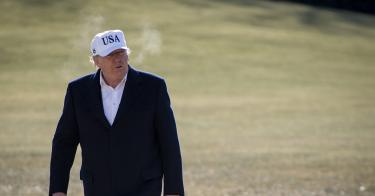Bad decisions produce undesirable consequences, which is why the U.S. needs to make wise decisions about its nuclear posture. A bad decision on nuclear policy could lead to greater proliferation of nuclear weapons, a fundamentally more violent world, and devastating attacks against us and our allies.
The Trump administration will release a new Nuclear Posture Review next month. It is expected to take a very different tack from that of the previous administration, which trumpeted its commitment to creating “a world without nuclear weapons.” And a different tack is sorely needed.
Obama’s “Russian reset” never took hold. It is now clear that post–Cold War hopes that Russia would become a constructive international partner were mere pipe dreams. If Russia’s 2008 invasion of Georgia was not a wake-up call, Moscow’s 2014 invasion of Ukraine underscored the reality that the only reset the Kremlin is interested in is reviving the Cold War. In addition to disregarding the safety and security of the U.S., Russia has threatened to nuke U.S. allies.
President Putin has stated that he can certainly envision using nuclear weapons during a conventional conflict. Indeed, the Russian strategic doctrine considers use of a nuclear weapon as a way to deescalate the conflict.
Russia emphasizes its willingness to use nuclear weapons because it worries about U.S. conventional capabilities. But those capabilities do not exist simply to keep a bellicose and aggressive Kremlin in check. Our armed forces serve many important missions around the globe, from ensuring the freedom of commons (air, sea, and space) to keeping international terrorist gangs at bay.
Moscow’s nuclear program is not “all talk” by any means. Since signing the New Strategic Arms Reduction Treaty, Russia has launched a robust nuclear-weapons-modernization program. Moscow has announced over 20 strategic nuclear-modernization programs in the past few years alone, and the Pentagon reportedly expects Russia to deploy a total force of 8,000 warheads by 2026.
Yet while Moscow has been building and burnishing its nuclear arsenal, the U.S. has been treading water at best. There is a tremendous need to modernize all components of our strategic nuclear arsenal: land-based ICBMs, bombers, and submarines, along with the missiles they launch. We must also modernize our nuclear-production complex, which no longer can produce anything close to the number of new warheads being produced by Russia or China.
The triad, as these systems are collectively known, will have to continue to deter large-scale attacks against the homeland and allies for decades to come. The emergence of new nuclear powers, such as North Korea, since the end of the Cold War further underscores the need for flexibility and resilience that the triad provides.
Much needs to be done to get the triad in shape to deal with the challenges ahead. The Congressional Budget Office estimates that existing plans for U.S. nuclear forces — less ambitious than what the Trump administration is expected to propose — would cost $400 billion over the 2017–2026 period. Paying for it may seem to be an insurmountable task, given the huge budget deficits we are already running.
But we’re talking about a truly necessary investment, considering the existential threats we face. In the words of Secretary of Defense James Mattis, “America can afford survival.”
Washington must address the egregious disparities in tactical and intermediate-range nuclear-weapons capabilities. Russia has about a ten-to-one advantage in tactical nukes. It continues to develop and deploy intermediate-range nuclear forces as if there were no arms-control agreement banning them. There is, but Putin has routinely violated it since about 2009.
What is the point of a treaty that limits only the United States? By failing to respond to Russia’s violations in any tangible manner, we signal to other countries that obeying arms-control agreements does not matter.
Of course, Russia is not the only concern. North Korea made waves earlier this year when it tested a hydrogen nuclear bomb. It continues to advance its long-range missiles to hold the United States at risk. China has a very capable nuclear-weapon complex and reportedly tests nuclear weapons. Iran got away with and was even rewarded for pursuing nuclear-weapon technologies. Our adversaries have not restrained their nuclear ambitions during the last quarter of a century. America’s general abandonment of nuclear modernization tempted none of our foes to cash a “peace dividend.”
Make no mistake, the triad is increasingly shabby. U.S. nuclear warheads are old; they were designed at the peak of the Cold War. Our once-robust nuclear-production complex has atrophied due to a lack of recapitalization and leadership interest.
While all Nuclear Posture Reviews since the Cold War have emphasized the importance of weapons science for maintaining U.S. nuke stockpile, they all fell short of addressing the need for infrastructure modernization. Some buildings in use today date back to the Manhattan Project. With warhead life-extension programs and a potentially greater production schedule on the horizon, the administration must address the need to modernize the U.S. nuclear-weapons complex.
Nuclear Posture Reviews are always revealing. They signal a president’s nuclear priorities to observers at home and to our friends and foes around the world. But a review is only a starting point; what matters more is how they are implemented. So stay tuned as the Trump administration’s nuclear-weapons policy unfolds over the years to come.
This piece originally appeared in The National Review



